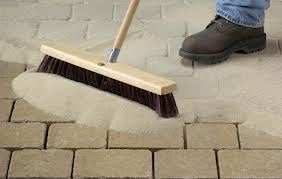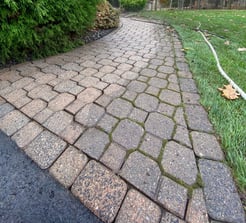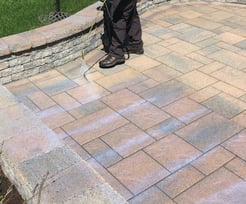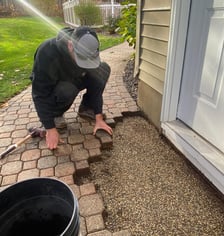Everyone loves a newly installed hardscape. We take pride in the newly renovated spaces we build and the upgraded curb appeal they provide. What we don't talk about enough is the routine maintenance needed to keep that beautiful hardscape looking its best for years to come.
Hardscape materials have advanced tremendously over the years. Manufacturers have revolutionized the aggregates and pigments used in their materials, extending the life of their products. There is however still basic cleaning and maintenance required. Without following a structured maintenance schedule, you will slowly see wear and tear on your outdoor living space. Left undone, this could contribute to erosion and costly repairs.
What should I expect to see after a hardscape installation?
Shortly after installation you may see some efflorescence on your pavers and walls. These are naturally occurring white chalky stains that develop on the face of concrete products. While they may seem unsightly, these stains dissipate in time. You can choose to have this haze removed by an annual cleaning and sealing. With time you may also start to notice the joint sand failing. This is usually signified by moss growth or wash out.
What hardscape maintenance services are available?
Joint Re-Sanding

Failing joint sand (signified by growing weeds, moss and ants hills/insects) along with all other joint contents are removed by pressure washing with a special nozzle and setting. Once the surface is dry, new high-performance Polymeric Joint-Sand is swept into the joints, and then compacted using a vibratory plate compactor. This process is repeated until the satisfactory density of polymers and sand is achieved. Sand is then moistened with a hose insequential steps to activate polymers (polymerization).

Cleaning
With a stripping agent, any previous sealant coating and residue will be removed (if applicable and necessary.) This is followed by cleaning with a Hardscape Cleaner/Paver Primer to free the surface of any ground in dirt, efflorescence, staining or oxidation. This also opens the concrete pores to “accept” the new sealer that will be applied.
Sealing

Using semi-gloss finishes, the surface will be sealed with either a natural-look, wet-look or clear-look water-based sealer. This leaves a water resistant, professional strength finish to protect from future wear, staining, dirt, and contamination. This helps to sustain and enhance the look & life of your hardscape. It also helps keep joints secure and protected from stains and aggregate depletion.
Repairs

Over time installations can shift and sink. There are many causes for this including poor drainage (such as improper down spout placement), excessive tire traffic, and edge restraint failure. Also, if your house doesn't have a gutter system installed, drip lines can cause permanent damage to the face of your hardscapes. The required hardscape repairs can range from leveling the base and reinstalling sunken pavers to replacing broken materials and reinstalling edge restraint, and so much more.
When should I have these hardscape services completed?
1 year after installation
While some pavers and hardscape materials come with built in sealing products, not all do. We recommend hardscape sealing to help preserve and protect your project be done within 6 months to a year after installation. This will help with joint sand longevity and long lasting stain protection. Once it is sealed it is recommended to repeat the process every 3-5 years.
2-3 years after installation
If no maintenance is done within the first year, it is typically recommended to have the entire installation deep cleaned by power washing and followed up with a sealing.
4 plus years after installation
About this time, you will want to take a good look at your hardscape project to determine if new joint sand is required, or if any minor touchups and repairs are necessary. Also at this time you can talk to our HCM specialists about any cleaning and sealing options they feel would benefit your project.
The goal to any well maintained hardscape is to keep up with a routine schedule preventatvie maintenance to protect your investment. Seal your recently installed job sooner rather than later to preserve its beauty, or have us restore your old project back to life. Our high-performance joint sands, cleaners & coatings will enhance the look and protect your investment from future wear, efflorescence, staining, and contaminants.

Related Articles:
The Top 7 Problems and Solutions for Interlocking Concrete Pavers
What is Joint Sand for Pavers?
What is the white stuff on my pavers and retaining walls?